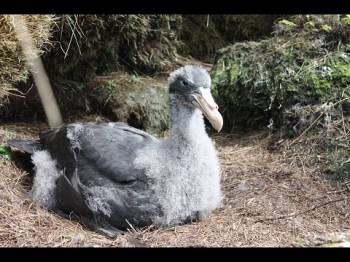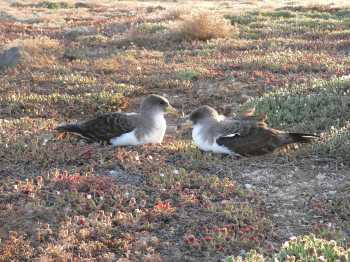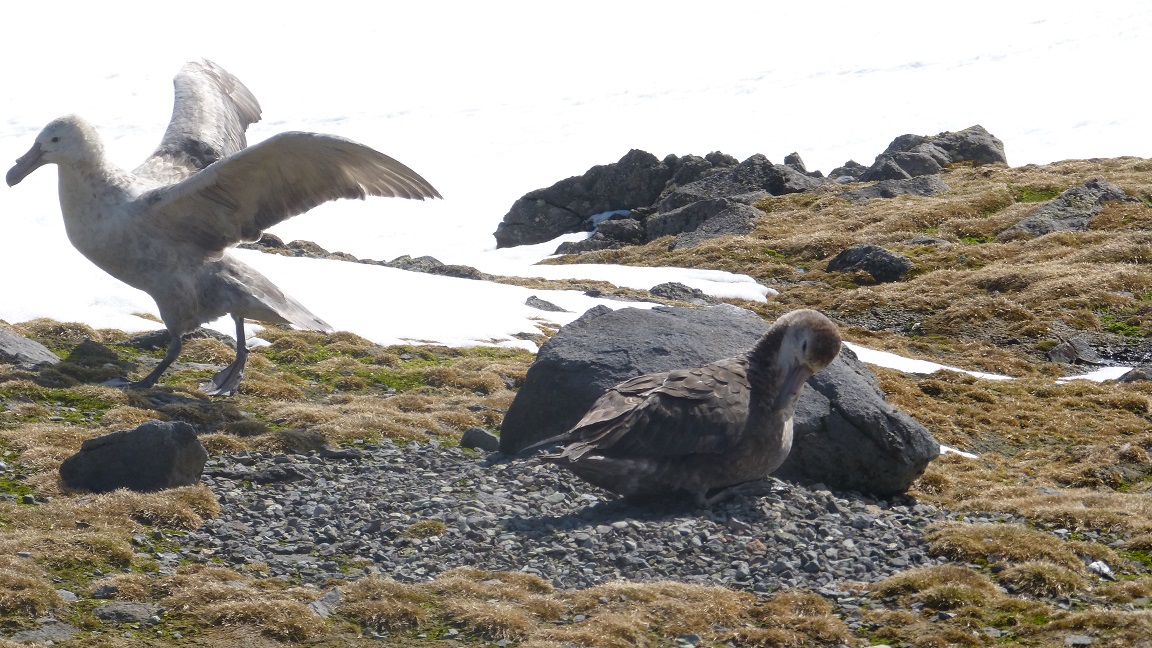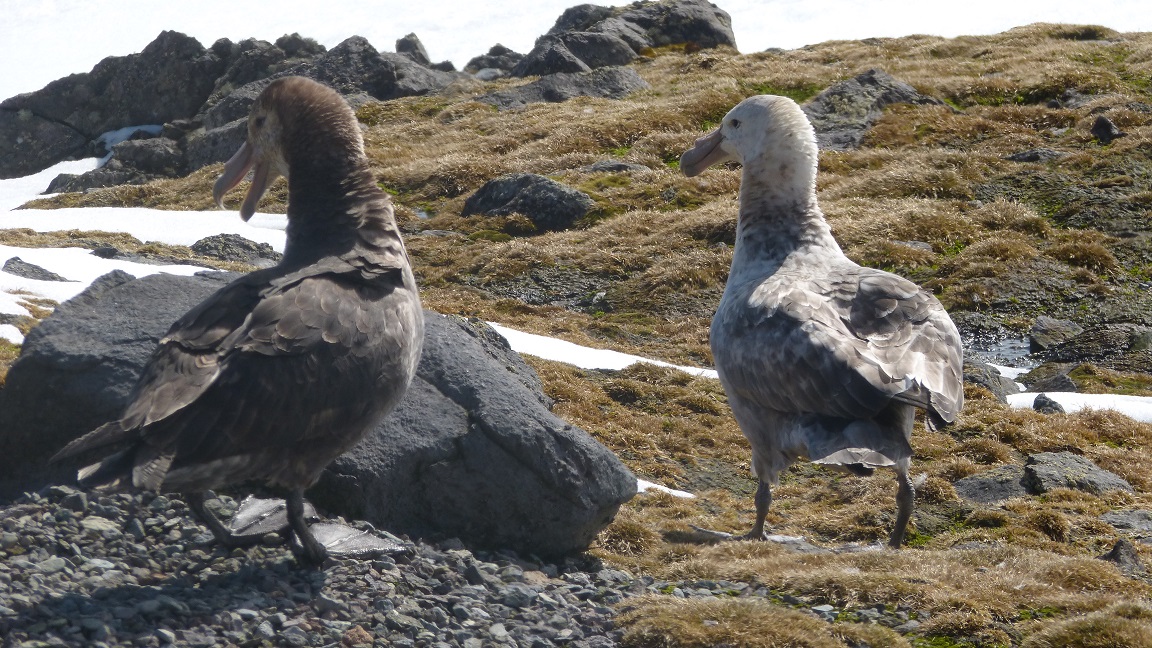King George Island is part of the South Shetland Island group and lies about 125 km from the northern tip of the Antarctic Peninsula. Admiralty Bay lies on the southern coast of the island between Martins Head and Demay Point. The bay is one of the most surveyed areas in Antarctica with the Brazilian Antarctic Programme having monitored its seabirds since 1984. A single ACAP-listed species breeds within Admiralty Bay, the Southern Giant Petrel Macronectes giganteus, on both the eastern and western shores of the bay.
The breeding site on the eastern entrance to the bay is at Vauréal Peak. This colony is located on gently sloping low cliffs, covered by mosses, lichens, scree and boulders. Nests are constructed mainly of pebbles. The most recent ground census undertaken marine mammals to utilize the area for breeding. The area has been monitored since 1985 by Brazilian researchers from the Universidade do Vale do Rio dos Sinos. In the austral summer of 2011/12 (on 28 November) the population size was 60 breeding pairs occupying an area of 0.3 ha. Previously in 1978/79 113 occupied nests were counted, suggesting a decrease. However, counts made since 2005 show the population has remained stable over the last decade.
Vauréal Peak falls within an Antarctic Specially Managed Area (ASMA No. 1) that includes the whole bay.
Southern Giant Petrels also breed on the western shore of Admiralty Bay where 10 nests were reported in 2004/05 within an Antarctic Specially Protected Area (ASPA No. 128), that falls within the ASMA. It has also been designated as an Important Bird Area (West Admiralty Bay ANT046) by BirdLife International for its Gentoo Penguin Pygoscelis papua population. Within the ASPA entry is only allowed under permit and “pedestrians should maintain the following minimum approach distances from wildlife, unless it is necessary to exceed these for purposes allowed for by the permit: ... Southern giant petrels – 50 m”.
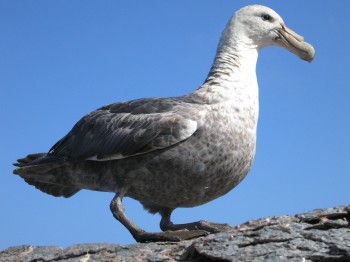
A Southern Giant Petrel in Antarctica, photograph by Michael Dunn
With thanks to Patricia Pereira Serafini.
Selected literature:
ATCM 2014. Management Plan for Antarctic Specially Managed Area No.1. Admiralty Bay, King George Island. XXXVII Final Report. Measure 4 (2014) Annex. pp. 227-276.
ATCM 2014. Management Plan for Antarctic Specially Protected Area No 128. Western Shore of Admiralty Bay, King George Island, South Shetland Islands. ATCM XXXVII Final Report. Measure 4 (2014) Annex. pp. 65-82.
Harris, C.M., Lorenz, K., Fishpool, L.D.C., Lascelles, B., Cooper, J., Coria, N.R., Croxall, J.P., Emmerson, L.M., Fijn, R., Fraser, W.L., Jouventin, P., LaRue, M.A., Le Maho, Y., Lynch, H.J., Naveen, R., Patterson-Fraser, D.L., Peter, H.-U., Poncet, S., Phillips, R.A., Southwell, C.J., van Franeker, J.A., Weimerskirch, H., Wienecke, B. & Woehler, E.J. 2015. Important Bird Areas in Antarctica 2015. Cambridge: BirdLife International and Environmental Research & Assessment Ltd. 302 pp.
Patterson, D.L., Woehler, E.J., Croxall, J.P., Cooper, J., Poncet, S., Peter, H.-U., Hunter, S. & Fraser, M.W. 2008. Breeding distribution and population status of the Northern Giant Petrel Macronectes halli and Southern Giant Petrel M. giganteus. Marine Ornithology 36: 115-124 & appendices.
Petry, M.V., Valls, F.C.L., de Souza Petersen, E., Krüger, L., da Cruz Piuco, R. & dos Santos, C R. 2016. Breeding sites and population of seabirds on Admiralty Bay, King George Island, Antarctica. Polar Biology 39: 1343-1349.
Poncet, S. & Poncet, J. 2007. Southern Ocean Cruising Second Edition. Cambridge: Environmental Research & Assessment. 160 pp.
Sander, M., Carneiro, A.P.B., Balbao, T.C, Bays, S.R., Costa, E.S., Mascarello, N.E., Oliva, T.D. & Santos, C.R.D. 2005. Status and trends of Antarctic seabirds at Admiralty Bay, King George Island. Polarforschung 75: 145-150.
Maria Virginia Petry & Júlia Victória Grohmann Finger, Laboratório de Ornitologia e Animais Marinhos, Universidade do Vale do Rio dos Sinos, São Leopoldo, Brazil, 14 June 2017
NOTE: photographs of Admiralty Bay and its breeding Southern Giant Petrels are required.
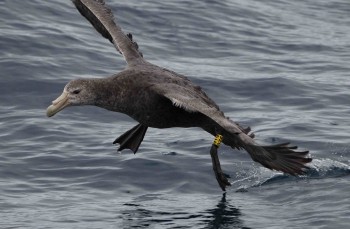

 English
English  Français
Français  Español
Español 